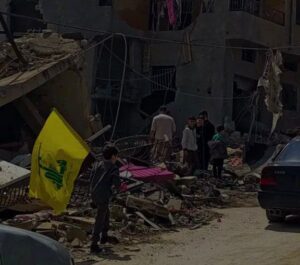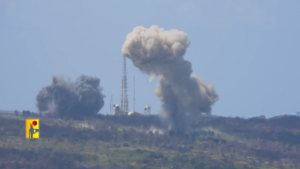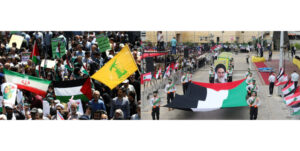In an article, we published immediately after the attack at the Megiddo junction, we assumed that the terrorist who planted the IED (March 13) set out from Lebanon and infiltrated Israeli territory through the Lebanese border. While the IED possessed characteristics from the Lebanese arena, it is not clear at this stage the exact infiltration point the terrorist infiltrated Israel, how the terrorist got to the Megiddo junction, and why was the Megiddo Junction selected from all locations. Clearly, the terrorist (most likely of Palestinian origin) tried to escape from the scene of the attack back to Lebanon but was caught and killed near the border.
Megiddo Junction is a busy central junction in northeastern Israel, which serves as one of the main junctions aggregating the traffic arteries from northern Israel to the center of the country. A large security prison housing Palestinian security prisoners is located near the Megiddo junction. The junction is located at a relatively small geographical distance from the area of Jenin (about 15 km northwest of Jenin). Jenin, a large city ruled by the Palestinian Authority, is currently a major Palestinian terrorist center.
Assessing the operational-conscience perception objectives of those responsible for the attack, Megiddo Junction is situated where carrying out an IED-type attack can cause great damage deep inside the State of Israel near a prison holding Palestinian prisoners. Only one vehicle was struck, seriously injuring one civilian. The proximity to the prison and Jenin immediately creates the symbolic-cognitive perception context.
Evaluating the deception-concealment goals of those responsible for the attack (based on the original assumption that the terrorist infiltrated Israel from Lebanon), an attack carried out at the Megiddo Junction can potentially shift (in the first stages of the investigation) the Israeli intelligence focus from the theory that the infiltration was carried out from Lebanon to another possibility, i.e., Can it be assumed that the terrorist (who originated from Lebanon) did not actually infiltrate Israel through the Lebanese border?
Physical infiltration routes from the Lebanese arena into Israeli territory can also be made indirectly from the Jordanian arena (high probability) and the Syrian arena (low probability):
The Jordanian option (possible route: Lebanon – Damascus – the Deraa – Irbid area – Beit Shean Valley – Jenin – Megiddo). This is the longest but more likely geographical option. The terrorist may have made his way from Lebanon (e.g. Masnaa border crossing) toward Damascus. From there, he may have continued to southern Syria to Deraa. From the area of Deraa, the terrorist may have crossed (allegedly on foot) the border into Jordan, reaching the area of Irbid. From there, he may have crossed the border into Israel in the Beit She’an Valley area, immediately continuing to Jenin in the Palestinian Authority. The borders between Syria and Jordan and between Jordan and Israel are not as guarded and secure as the border between Syria and Israel and Lebanon and Israel.
The drug smuggling industry between Syria and Jordan in the Deraa area is blooming. The Jordanian army finds it very difficult to prevent. Attempts to smuggle weapons between Jordan and Israel occur almost every week, even several times a week. Some attempts are thwarted, and some are evidently successful. Similar to Israel’s border with Lebanon, on Israel’s border with Jordan, drug and weapons smuggling is a definitive platform for terrorist acts.
As for the attack in Megiddo, on March 21 it was formally announced that the terrorist penetrated from Lebanon into Israeli territory using a ladder.

The Syrian option (possible route: Khader – Majdal Shams area – Megiddo). The vast majority of the Israeli border with Syria is protected by a massive high fence and well monitored by special means. This border is difficult to infiltrate. However, this does not mean that it cannot be penetrated. Based on the possibility that the terrorist came from Syria, it can be assumed that the terrorist reached Israeli territory through the Druze village of Khader by way of the slopes of Mount Hermon and, from there, he may have entered the area of the Druze village of Majdal Shams, which is located in the Israeli Golan Heights, on foot. In Khader, there is a Hezbollah and Hezbollah proxy presence. It is possible that collaborators in the Majdal Shams area were waiting to drive him to the Megiddo junction. He could have made his way to Khader on foot and/or donkey through Wadi Shebaa with the assistance of smugglers. Alternatively, he may have driven by car through the Al-Mitzna crossing (for example), from there to the Damascus area and then to Khader.

The involvement of additional units in the above options (assuming that Hezbollah is responsible or involved in this attack). In addition to the units/individuals mentioned in the article we published on March 16, other units may be involved in the Syrian and Jordanian scenario options. It is possible that in the option of the terrorist crossing in the Syrian arena, Hezbollah’s southern headquarters unit in southern Syria was involved. In the Jordanian option, Talal Hamiyeh (“Abu Ja’far” – see appendix regarding him), head of Hezbollah’s foreign terrorist unit (Unit 910), may have been involved.
In both options, it can be assumed that the terrorist’s movement was under Hezbollah’s patronage, and the terrorist was led and closely accompanied by collaborators. The overall involvement of Quds Force Unit 840 in these arenas cannot be ruled out.
Appendix – Talal Hamiyeh:

Full Name: Talal Husseini Hamiyeh (طلال حسني حميه)
Nickname: Abu-Ja’far (أبو جعفر) | Named after his eldest son, Muhammad Ja’far Talal Hamiya (محمد جعفر طلال حميه)
Pseudonym: Ismamet Mazrani (عصمت ميزاراني)
Date of birth: 03.05.1958
Father’s Name: Husni Hamiyeh (حسني حميه)
Mother’s Name: Ghazaleh Hamiyeh (غزالة حميه)
Personal status: Married to Freiel Daher (فريال ضاهر)
Family home address: 54 Taraiyya, Ba’albek, Beqaa Valley, Lebanon
Position: Previously, he served as Mad Mughniyeh’s deputy until the latter was assassinated. In his last formal position, he is known as Hezbollah’s chief intelligence officer and in charge of the foreign terrorist unit (Unit 910).





